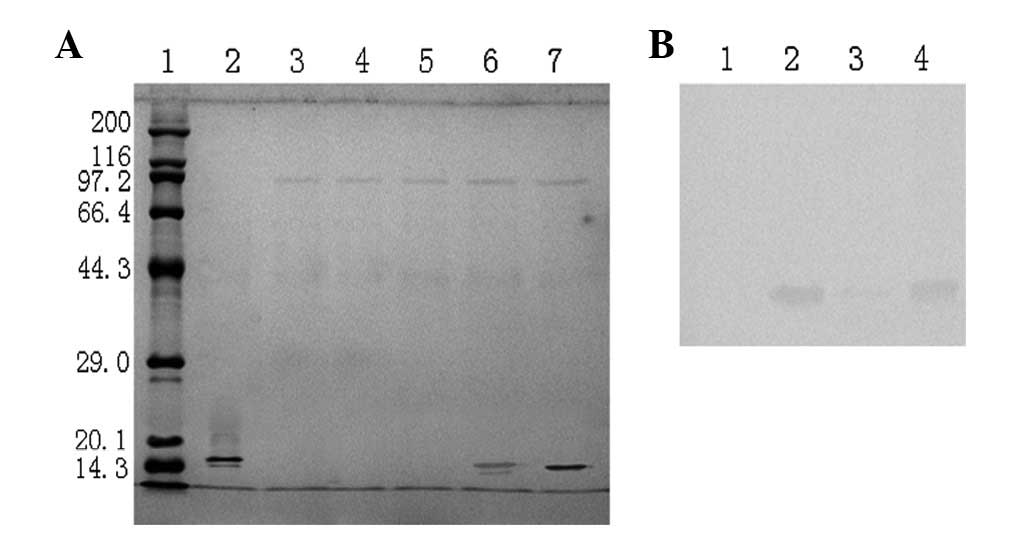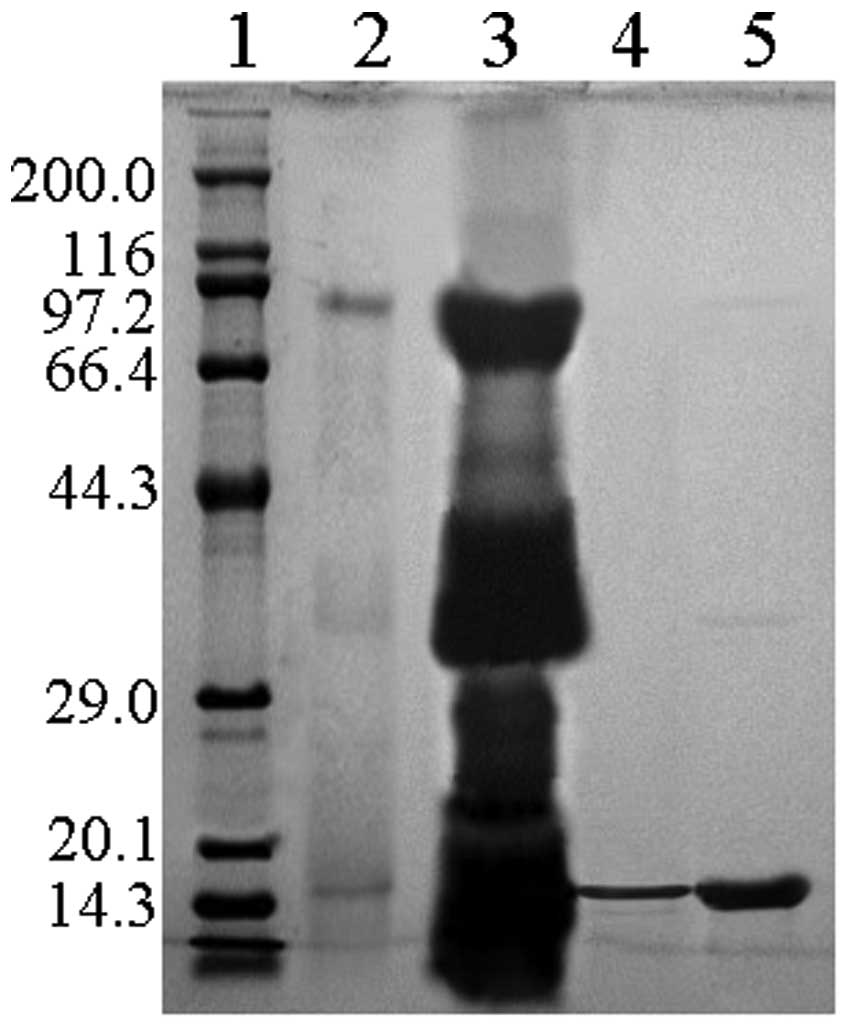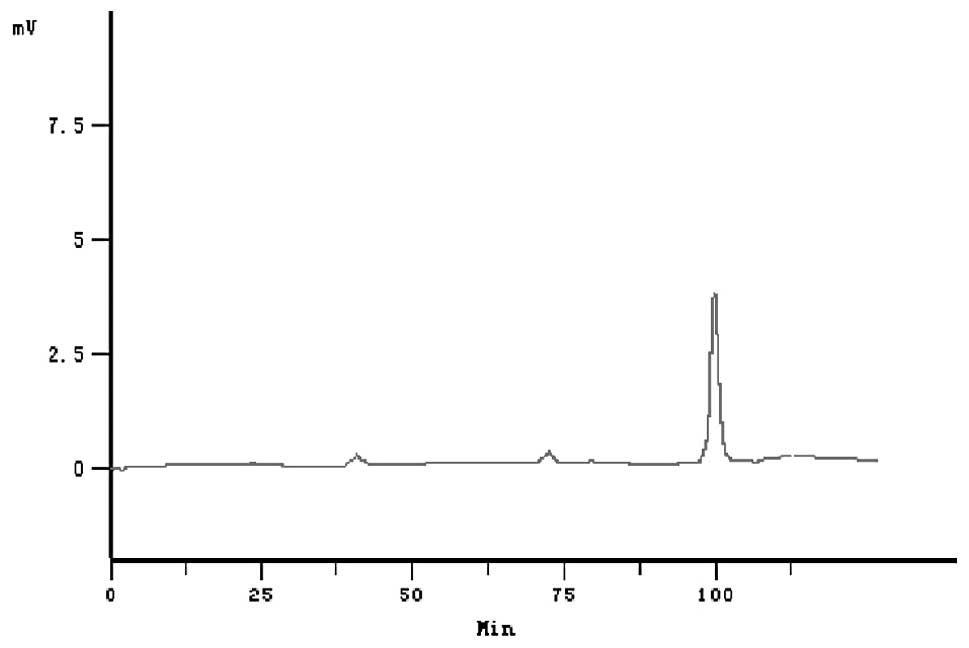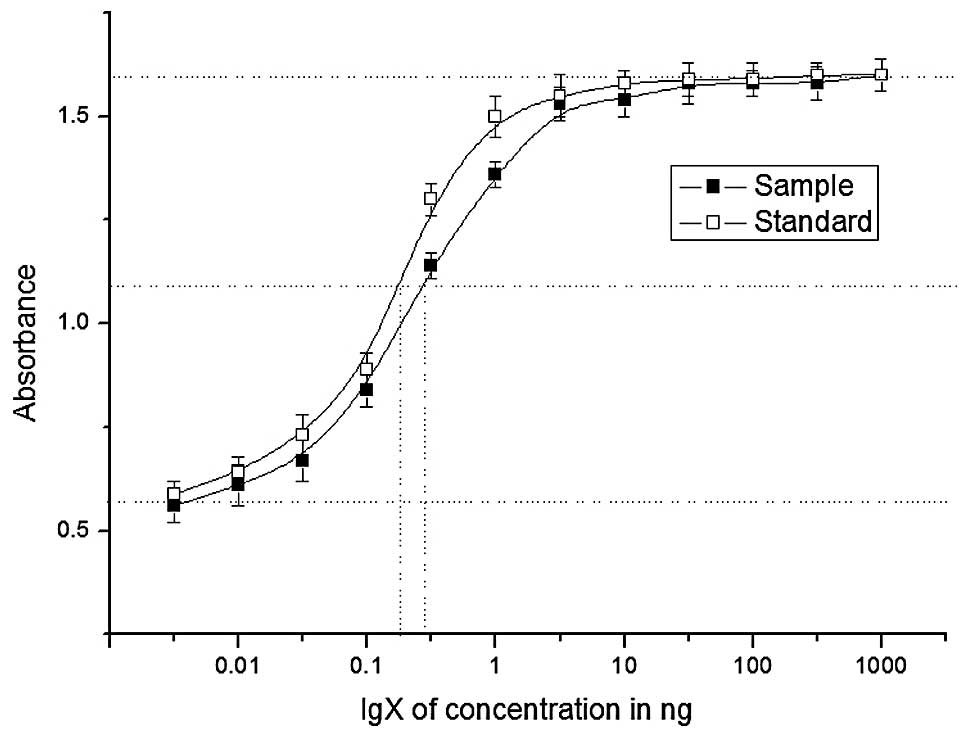Expression, purification and characterization of human interferon-γ in Pichia pastoris
- Authors:
- Published online on: November 19, 2013 https://doi.org/10.3892/mmr.2013.1812
- Pages: 715-719
Abstract
Introduction
An interferon-like virus inhibitor, later designated as IFN-γ, was identified in phytohemagglutinin (PHA)-stimulated human leukocyte cultures (1). IFN-γ is secreted by NK cells, γδT cells and CD8+/CD4+ T cells, which undergo activation by antigens, mitogens or alloantigens. IFN-γ is important in the control of intracellular infection, immunoregulation, tumor development, hypersensitivity reactions, and autoimmune diseases (2,3). Due to its numerous biological and pathological functions, human IFN-γ (hIFN-γ) is used extensively to treat drug-resistant tuberculosis (4), atopic dermatitis (5) and hepatitis B infections (6).
Obtaining large quantities of pure hIFN-γ is important for clinical studies and mechanistic investigations. Previous studies have reported that recombinant hIFN-γ (rhIFN-γ) was produced by an adenovirus (7), Escherichia coli (E. coli) (8–10), Saccharomyces cerevisiae (11), bicistronic baculovirus insects (12) and Chinese hamster ovary (CHO) cells (13,14). However, complex manipulations, high culture expenses, low yields or low biological activity limit the use of these expression systems. The methylotrophic yeast, Pichia pastoris (P. pastoris), is frequently used as an expression system for the production of proteins. P. pastoris possesses prokaryotic features including clear genetic background, easy manipulation, high cell densities and low cost, and eukaryotic features including protein folding, post-translational modification and secretion.
In general, the secretion of a protein of interest into the culture medium is preceded by an N-terminal extension of 3–60 amino acids, forming a signal peptide, which targets the propeptide of the endoplasmic reticulum followed by cleavage using membrane bound signal peptidases. hIFN-γ has a native signal sequence of 23 amino acids, which directs its secretion from human lymphocyte cells. The Saccharomyces cerevisiae α-mating factor (MF-α) prepro sequence is widely used in P. pastoris cells to secrete heterologous proteins. MF-α consists of a signal sequence of 19 amino acids followed by a 66-residue sequence. The heterologous protein, fused with the signal sequence, is cleaved by the KEX2 or STE13 gene product, at the site following the dibasic paired residues Lys-Arg or Glu-Ala, respectively. In this study, we compared the secretion level of rhIFN-γ under the native secretion signal of hIFN-γ versus the MF-α signal peptide, to achieve a native N-terminal, and a higher quantity of a biologically active rhIFN-γ.
Materials and methods
Materials
P. pastoris X-33, pPICZaC vector, and Zeocin™ antibiotic were purchased from Invitrogen (Carlsbad, CA, USA). E. coli XL-Blue cells were purchased from Beijing Dingguo Biotechnology Company (Beijing, China). Restriction enzymes, DNA markers and protein markers were purchased from Takara (Dalian, China). The plasmid extraction kit was purchased from Feyou Biotechnology Co., Ltd. (Guangzhou, China). Primers and the coding sequence of hIFN-γ were synthesized by Sangon Biotechnology Co. (Shanghai, China). The rabbit anti-IFN-γ polyclonal antibody was purchased from Abcam (Cambridge, UK). Goat anti-rabbit IgG labeled with HRP was purchased from Beijing Dingguo Biotechnology Company. Vivaflow 200 polyethersulfone (PES) 50,000 molecular weight cut-offs (MWCO) and PES 10,000 MWCO and Vivaspin 2 ml were purchased from Sartorius Stedim Biotech GmbH (Goettingen, Germany). SP Sepharose XL and Superdex G75 were purchased from GE Healthcare Bio-Sciences Co. (Piscataway, NJ, USA). Standard hIFN-γ was purchased from Novoprotein (Shanghai, China). A Bradford protein assay kit was purchased from Beyotime (Shanghai, China).
Construction of expression vectors
The coding sequence of hIFN-γ, flanked with BspT1041 and KpnI, was synthesized by Sangon Biotechnology Co. based on the codon preference in P. pastoris, and the fragment between the BspT1041 and KpnI sites was inserted into pPICZαC at the same sites to generate pNhIFN. The optimized sequence encoding hIFN-γ flanked with BspT1041 and KpnI was as follows: TTCGAAACGATGAAGTATACTAGTTAC ATCTTAGCCTTTCAATTGTGCATTGTTCTTGGTTC TTTGGGATGTTATTGTCAAGATCCATACGTTAAGGA GGCCGAGAACCTAAAGAAATACTTTAACGCCGGCCA TGACGTGGCAGATAATGGGACTTTCTCGTTTTTGGG TATTCTGAAAAATTGGAAGGAAGAGTCCGATAGAAA GATTATGCAATCCCAGATCGTAAGTTTCTACTTCAAG CTGTTTAAAAATTTCAAGGACGATCAGTCTATACAA AAATCAGTGGAGACCATTAAAGAAGACATGAACGTC AAGTTCTTCAACTCTAACAAAAAGAAGAGAGATGAT TTTGAAAAACTAACCAATTATTCTGTTACAGACCTGA ATGTTCAGAGAAAAGCTATACATGAATTAATCCAGG TCATGGCTGAACTTTCACCTGCTGCTAAAACGGGTA AACGAAAGAGATCACAAATGTTGTTTCGTGGAAGGA GAGCATCCCAATAAGGTACC. The recognition sequences for restriction enzymes BspT1041 and KpnI are underlined, and the bold shows the native secretion signal peptide of hIFN-γ.
To construct a plasmid containing the hIFN-γ gene with an MF-α signal sequence containing a Kex2 cleavage site (Lys-Arg), primers containing XhoI and XbaI recognition sites were used. In order to create a Kex2 cleavage site upstream of the coding sequence of the mature hIFN-γ, bases coding for Lys-Arg were incorporated in the forward primer. Forward primer, 5′-GCCTCGAGAAGAGACAAGATCCATACG-3′; the recognition site for XhoI is underlined, and the bold letters signify the encoded region of the MF leader peptide of the Kex2 cleavage site (Lys-Arg). Reverse primer, 5′-CCGTCTAGATTATTGGGATGCTCTCC-3′; the recognition site for XbaI is underlined, and the stop codon is in bold.
The polymerase chain reaction (PCR) was performed using the vector pNhIFN as a template, using 33 cycles of 94ºC for 30 sec, 55ºC for 40 sec and a final extension of 5 min at 72ºC. The product was digested with XhoI and XbaI and ligated into pPICZαC at the same sites, generating pαIFN. pNhIFN and pαIFN were verified by DNA sequencing.
Vector transformation into P. pastoris and screening with genomic PCR
pNhIFN and pαIFN were isolated using an Omega Bio-Tek plasmid mini kit (Norcross, GA, USA), linearized with SacI and transformed into the X-33 strain of P. pastoris according to the transformation protocol (Invitrogen). The transformed cells were selected on YPD (yeast extract, peptone and dextrose) containing Zeocin (100 μg/ml). Zeocin-resistant clones were isolated and the integration of hIFN-γ was confirmed by PCR using AOX1 universal primers: forward, 5′-GACTGGTTCCAATTGACAAGC-3′ and reverse, 5′-GCAAATGGCATTCTGACATCC-3′. Thirty amplification cycles were performed at 94ºC for 30 sec, 55ºC for 30 sec, and a final extension for 5 min at 72ºC.
Detection of the insertion copy number
It has been reported that multiple copies of the transgene may integrate following electroporation and that the gene dosage may affect the expression levels of the recombinant protein (15). Therefore, in order to achieve a more physiologically comparable result, quantitative PCR (qPCR) was used to determine the copy number of the transgenes in the positive transformants. The hIFN-γ insertion copy number was examined three times for each positive clone. Data were normalized against the ACT1 gene as an endogenous control (housekeeping gene). The primers used were: hIFN-γ, forward: 5′-AGGAAGAGTCCGATAGAAAG-3′ and reverse: 5′-TCAGCCATGACCTGGATTAA-3′; ACT1, forward: 5′-TCATGGTCGGTATGGGTCAA-3′ and reverse: 5′-ACGATACCGTGCTCGATTGG-3′.
Genomic DNA was used as the template for qPCR analysis. Reaction conditions were established according to the SYBR® Premix Ex Taq™ II manual (Takara). Each 20-μl reaction contained 10 μl SYBR Premix Ex Taq II (2×), 10 μM forward and reverse primers (1 μl each), 2 μl sample genomic DNA and 6 μl sterile double deionized water. qPCR reactions were run in triplicate on ABI7000 (Applied Biosystems, Foster City, CA, USA) under the following conditions: 95ºC for 30 sec, followed by 40 cycles of 95ºC for 5 sec and 60ºC for 30 sec. The amplicon specificity was verified by analyzing the melting curve after 40 cycles and by agarose gel electrophoresis.
Expression of hIFN-γ in P. pastoris
Single copy clones were placed in 10 ml buffered glycerol-complex (BMGY) medium (1.0% yeast extract, 2.0% peptone, 1.34% yeast nitrogen base, 4×10−5 biotin, 100 mM potassium phosphate, pH 6.0, and 1.0% glycerol) and incubated at 30ºC for 24 h. Subsequently, the cells were harvested by centrifugation for 5 min at 1500 × g and resuspended in 10 ml buffered methanol-complex (BMMY) medium (BMGY medium with 0.5% methanol instead of 1.0% glycerol). Methanol was added to a final concentration of 0.5% (v/v) every 24 h. To detect the expression of rhIFN-γ in the supernatant, 12% (w/v) Tricine-SDS-PAGE, western blot analysis and amino-terminal sequencing were performed. Tricine-SDS-PAGE analysis was performed using a 12% gel according to the protocol proposed by Schägger (16).
For western blot analysis, proteins were transblotted onto a polyvinylidene fluoride (PVDF) membrane. The membrane was blocked using 5% BSA in Tris-buffered saline with Tween (TBST) (150 mM NaCl, 25 mM Tris, and 0.05% Tween-20, pH 7.5) for 2 h at room temperature, and subsequently incubated with mouse anti-HSA monoclonal antibody at 4ºC overnight. After being washed three times with TBST, the membrane was incubated with goat anti-mouse IgG conjugated to horseradish peroxidase (HRP) (Beijing Dingguo Biotechnology Company) for 2 h at room temperature. Finally, the membrane was washed with TBST and proteins were detected with 3,3′-diaminobenzidine (DAB).
The amino-terminal sequence of rhIFN-γ was determined using automated Edman degradation performed on a model PPSQ-21A protein sequencer (Shimadzu, Japan).
Purification of rhIFN-γ
To purify rhIFN-γ from the culture supernatant, 5 liters of P. pastoris culture were centrifuged at 1,500 × g for 15 min. As the molecular weight of rhIFN-γ is 17 kDa, proteins in the supernatant with a molecular weight of 10–50 kDa were isolated and concentrated using Vivaflow 200 PES 50,000 MWCO and PES 10,000 MWCO. The concentrated sample was loaded onto the SP Sepharose XL for further separation, as the isoelectric point of hIFN-γ is ~8.1–9.1. The rhIFN-γ fraction was concentrated by Vivaspin 2 ml. Fractions of each step were analyzed on 15% Tricine-SDS-PAGE. The rhIFN-γ fraction was stored at −20ºC. Protein concentration was determined using a Bradford protein assay kit. The purity of rhIFN-γ was determined by HPLC analysis.
Activity assay of hIFN-γ
The antiviral activity of rhIFN-γ was evaluated as previously described (17). The human carcinoma cell line, HEP2C, was challenged with the encephalomyocarditis virus (EMCV) in the presence or absence of hIFN-γ. Antiviral activity was calculated in comparison with the standard obtained from Novoprotein.
Results
Construction of expression plasmids and transformation of P. pastoris
The 516-bp gene fragment encoding hIFN-γ in addition to the BspT1041 and KpnI sites was synthesized by Sangon Biotechnology Co. and subcloned into pPICZαC in order to generate the recombinant plasmid, pNhIFN. The 451-bp gene fragment, encoding the mature hIFN-γ in addition to the XhoI and XbaI sites, was amplified by PCR from pNhIFN and subcloned into pPICZαC to generate the recombinant plasmid, pαIFN. Nucleotide sequencing analysis confirmed that the plasmids contained the correct hIFN-γ gene (data not shown).
In order to integrate hIFN-γ into the genome of P. pastoris by homologous recombination, the plasmids were linearized with SacI and transformed into electrocompetent P. pastoris cells. Successful integration was confirmed by PCR using AOX1 universal primers. The PCR results revealed that in positive yeast transformants there was one band of ~787 bp (pNhIFN) or 948 bp (pαIFN). The cells transformed with a pPICZαC empty plasmid were used as a negative control, and in these cells one band of ~588 bp was identified. qPCR data indicated that 90% of transformants contained a single copy of the gene, with only single-copy integrants being selected for the comparison experiments.
Expression and detection of rhIFN-γ in P. pastoris
Single-copy clones of each strain were inoculated in BMGY medium for 24 h and induced in BMMY medium for the expression of rhIFN-γ. Each strain was analyzed for rhIFN-γ expression on Tricine-SDS-PAGE following 96 h of induction. Fig. 1A shows a Coomassie-stained Tricine-SDS-PAGE of supernatants collected from induced P. pastoris cultures transformed with the expression plasmids of the pPICZαC control, pNhIFN or pαIFN. The supernatant of the control strain (lane 3) did not reveal any band corresponding to the standard rhIFN-γ (lane 2). The supernatant of the P. pastoris strain transformed with pNhIFN (lanes 4 and 5), containing the hIFN-γ gene with the native secretion signal peptide, did not reveal a rhIFN-γ protein band. The supernatant of the P. pastoris strain transformed with pαIFN (lanes 6 and 7), containing the hIFN-γ gene with the MF-α signal peptide, showed one protein band that was slightly higher than the hIFN-γ band.
Western blot analysis using an anti-human IFN-γ antibody confirmed that the protein band from the supernatant of the pαIFN-transformed strain was hIFN-γ (Fig. 1B, lane 4). However, it showed a faint band in the supernatant of the pNhIFN-transformed P. pastoris strain (Fig. 1B, lane 3). These results suggest that the native hIFN-γ secretion signal peptide is capable of secreting particularly low levels of hIFN-γ that may only be detected by western blot analysis, as it is more sensitive than Coomassie staining Tricine-SDS-PAGE.
Therefore, only the MF-α signal peptide cleavage site of the recombinant rhIFN-γ was examined, and N-terminal sequencing revealed that the first 14 amino acids of rhIFN-γ were QDPYVKEAENLKKY, which were identical to the N-terminal sequence of hIFN-γ, thus confirming the successful expression of the protein.
Purification and biological activities of rhIFN-γ in P. pastoris
Following the isolation and concentration of rhIFN-γ from the P. pastoris cultures, rhIFN-γ was then purified with cation exchange chromatography (SP Sepharose XL), using an AKTA Explorer 100 chromatography system. The optimal pH of the 50 mM acetate buffer for binding was 5.0 and the optimal NaCl (Beijing Dingguo Biotechnology Company) concentration for elution was 0.4 M. The rhIFN-γ fraction was concentrated by Vivaspin 2 ml. Following these procedures, from 5 liters of culture medium, we obtained a total of 800 mg of purified rhIFN-γ. rhIFN-γ achieved a purity of 96.7% as revealed by Tricine-SDS-PAGE and HPLC (Figs. 2 and 3). Protein recovery and purity of rhIFN-γ at the various purification steps are shown in Table I.
Table ISummary of purification steps of recombinant human interferon-γ (rhIFN-γ) from Pichia pastoris. |
To determine the antiviral effects of purified rhIFN-γ, an antiviral assay was performed by challenging HEP2C cells with EMCV in the presence of varying concentrations of rhIFN-γ. In three determinations, the calculated specific activity of rhIFN-γ ranged from 1×107 to 1.6×107 IU/mg protein, as assessed against the standard (Fig. 4). The results demonstrated that rhIFN-γ produced by P. pastoris had lower levels of biological activity compared with the standard obtained from Novoprotein, however, the simpler purification strategy makes this a useful method.
Discussion
hIFN-γ is a cytokine with multiple biological and pharmaceutical functions (2,18), thus it is expressed in a variety of systems, particularly in E. coli and CHO cells. The disadvantage of E. coli is that the accumulation of rhIFN-γ forms inactive and insoluble aggregates known as inclusion bodies. Although a variety of techniques have been developed to produce active recombinant proteins (dilution, diafiltration, urea, combined urea-ammonium chloride, chaperones, detergent-assisted and chromatography refolding), the complex procedures may lead to a low yield of the active product (10,19–21). Furthermore, rhIFN-γ expressed in E. coli is different from native mature hIFN-γ, as its N-terminal amino acid is methionine, which may have clinical and pharmaceutical side effects. The disadvantage of the CHO cell system is the low productivity of rhIFN-γ. Although culturing recombinant CHO cells at 32ºC may increase the productivity of rhIFN-γ, it is <10 mg/l. In our study, we used the P. pastoris system to express rhIFN-γ due to of the following features: low cost, high productivity, a strong regulated AOX1 promoter, growth to a high cell density in a simple medium and stable integration of heterogeneous genes into the genome. Furthermore, P. pastoris secretes few endogenous proteins to the culture medium, making purification of recombinant proteins easier.
In the P. pastoris expression system, the secretion signal peptide is essential for the successful expression of heterologous proteins. For IFN-α2b expression, the native secretion signal of IFN-α2b did not secrete the protein, but the α-prepro sequence without the EAEA repeats secreted 200 mg/l IFN-α2b into the culture medium (22). Expression of human serum albumin, using its native signal peptide, has been reported to produce >1 g/l (23). For the secretory efficiency of recombinant xylanase xynB, the bovine β-casein signal peptide was less efficient than the α-factor prepro sequence (24). Polygalacturonase genes were expressed in P. pastoris with the native signal peptide or the α-factor secretion signal peptide, but only slight differences in expression were observed (25). As signal peptides secrete recombinant proteins with varying efficiencies, it is important to examine different signal peptides that secrete the same protein in P. pastoris. In this study, hIFN-γ was successfully expressed in P. pastoris using either the native signal peptide of hIFN-γ or the α-factor signal peptide, although the former mediated trace levels of rhIFN-γ secretion, while the latter mediated secretion of 300 mg/l rhIFN-γ into the culture medium with the same amino terminal sequence as that of the native protein.
The biologically active form of hIFN-γ is a homodimer that interacts with a heterodimeric receptor consisting of INF-γ receptor 1 and 2 (26,27). In our study, the activity of rhIFN-γ was only slightly lower than that of the hIFN-γ standard, suggesting that the majority of the rhIFN-γ dimerized following the correct secretion into the culture, while small quantities of the rhIFN-γ may have remained in the monomer form or formed other complex structures. In conclusion, results of this study demonstrate that large quantities of biologically active rhIFN-γ may be produced from P. pastoris.
Acknowledgements
The authors would like to thank Jilin Department of Health, Jilin, China, for their financial support (no. 2011I087).
References
|
Wheelock EF: Interferon-like virus-inhibitor induced in human leukocytes by phytohemagglutinin. Science. 149:310–311. 1965. View Article : Google Scholar | |
|
Chen J and Liu X: The role of interferon gamma in regulation of CD4+ T-cells and its clinical implications. Cell Immunol. 254:85–90. 2009. View Article : Google Scholar : PubMed/NCBI | |
|
Billiau A and Matthys P: Interferon-gamma: a historical perspective. Cytokine Growth Factor Rev. 20:97–113. 2009. View Article : Google Scholar : PubMed/NCBI | |
|
Suárez-Méndez R, García-García I, Fernández-Olivera N, Valdés-Quintana M, Milanés-Virelles MT, Carbonell D, Machado-Molina D, Valenzuela-Silva CM and López-Saura PA: Adjuvant interferon gamma in patients with drug-resistant pulmonary tuberculosis: a pilot study. BMC Infect Dis. 4:442004.PubMed/NCBI | |
|
Chang TT and Stevens SR: Atopic dermatitis: the role of recombinant interferon-gamma therapy. Am J Clin Dermatol. 3:175–183. 2002. View Article : Google Scholar : PubMed/NCBI | |
|
Parvez MK, Sehgal D, Sarin SK, Basir SF and Jameel S: Inhibition of hepatitis B virus DNA replicative intermediate forms by recombinant interferon-gamma. World J Gastroenterol. 12:3006–3014. 2006.PubMed/NCBI | |
|
Xu R, Ying B, Zhao S, Li C and Wang Y: Construction and identification of a recombinant adenovirus which expresses human interferon-gamma. Chin J Biotechnol. 13:1–8. 1997.PubMed/NCBI | |
|
Arakawa T, Hsu YR and Yphantis DA: Acid unfolding and self-association of recombinant Escherichia coli derived human interferon gamma. Biochemistry. 26:5428–5432. 1987. View Article : Google Scholar : PubMed/NCBI | |
|
Zhang Z, Tong KT, Belew M, Pettersson T and Janson JC: Production, purification and characterization of recombinant human interferon gamma. J Chromatogr. 604:143–155. 1992. View Article : Google Scholar : PubMed/NCBI | |
|
Mohammadian-Mosaabadi J, Naderi-Manesh H, Maghsoudi N, Nassiri-Khalili MA, Masoumian MR and Malek-Sabet N: Improving purification of recombinant human interferon gamma expressed in Escherichia coli; effect of removal of impurity on the process yield. Protein Expr Purif. 51:147–156. 2007. View Article : Google Scholar : PubMed/NCBI | |
|
Fieschko JC, Egan KM, Ritch T, Koski RA, Jones M and Bitter GA: Controlled expression and purification of human immune interferon from high-cell-density fermentations of Saccharomyces cerevisiae. Biotechnol Bioeng. 29:1113–1121. 1987. View Article : Google Scholar : PubMed/NCBI | |
|
Chen YJ, Chen WS and Wu TY: Development of a bi-cistronic baculovirus expression vector by the Rhopalosiphum padi virus 5′ internal ribosome entry site. Biochem Biophys Res Commun. 335:616–623. 2005. View Article : Google Scholar : PubMed/NCBI | |
|
Devos R, Opsomer C, Scahill SJ, Van der Heyden J and Fiers W: Purification of recombinant glycosylated human gamma interferon expressed in transformed Chinese hamster ovary cells. J Interferon Res. 4:461–468. 1984. View Article : Google Scholar | |
|
Tan HK, Lee MM, Yap MG and Wang DI: Overexpression of cold-inducible RNA-binding protein increases interferon-gamma production in Chinese-hamster ovary cells. Biotechnol Appl Biochem. 49:247–257. 2008. View Article : Google Scholar : PubMed/NCBI | |
|
Li K, Gao H, Gao L, Qi X, Gao Y, Qin L, Wang Y and Wang X: Recombinant gp90 protein expressed in Pichia pastoris induces a protective immune response against reticuloendotheliosis virus in chickens. Vaccine. 30:2273–2281. 2012.PubMed/NCBI | |
|
Reddy PK, Reddy SG, Narala VR, Majee SS, Konda S, Gunwar S and Reddy RC: Increased yield of high purity recombinant human interferon-gamma utilizing reversed phase column chromatography. Protein Expr Purif. 52:123–130. 2007. View Article : Google Scholar : PubMed/NCBI | |
|
Zaidi MR and Merlino G: The two faces of interferon-gamma in cancer. Clin Cancer Res. 17:6118–6124. 2011. View Article : Google Scholar : PubMed/NCBI | |
|
Yan X, Hu S, Guan YX and Yao SJ: Coexpression of chaperonin GroEL/GroES markedly enhanced soluble and functional expression of recombinant human interferon-gamma in Escherichia coli. Appl Microbiol Biotechnol. 93:1065–1074. 2012. View Article : Google Scholar : PubMed/NCBI | |
|
Petrov S, Nacheva G and Ivanov I: Purification and refolding of recombinant human interferon-gamma in urea-ammonium chloride solution. Protein Expr Purif. 73:70–73. 2010. View Article : Google Scholar : PubMed/NCBI | |
|
Jin T, Guan YX, Yao SJ, Lin DQ and Cho MG: On-column refolding of recombinant human interferon-gamma inclusion bodies by expanded bed adsorption chromatography. Biotechnol Bioeng. 93:755–760. 2006. View Article : Google Scholar : PubMed/NCBI | |
|
Ghosalkar A, Sahai V and Srivastava A: Secretory expression of interferon-alpha 2b in recombinant Pichia pastoris using three different secretion signals. Protein Expr Purif. 60:103–109. 2008. View Article : Google Scholar : PubMed/NCBI | |
|
Kobayashi K, Kuwae S, Ohya T, Ohda T, Ohyama M, Ohi H, Tomomitsu K and Ohmura T: High-level expression of recombinant human serum albumin from the methylotrophic yeast Pichia pastoris with minimal protease production and activation. J Biosci Bioeng. 89:55–61. 2000. View Article : Google Scholar : PubMed/NCBI | |
|
He Z, Huang Y, Qin Y, Liu Z, Mo D, Cong P and Chen Y: Comparison of alpha-factor preprosequence and a classical mammalian signal peptide for secretion of recombinant xylanase xynB from yeast Pichia pastoris. J Microbiol Biotechnol. 22:479–483. 2012. View Article : Google Scholar : PubMed/NCBI | |
|
Cho IJ, Yeo IC, Lee NK, Jung SH and Hahm YT: Heterologous expression of polygalacturonase genes isolated from Galactomyces citri-aurantii IJ-1 in Pichia pastoris. J Microbiol. 50:332–340. 2012. View Article : Google Scholar : PubMed/NCBI | |
|
Ealick SE, Cook WJ, Vijay-Kumar S, Carson M, Nagabhushan TL, Trotta PP and Bugg CE: Three-dimensional structure of recombinant human interferon-gamma. Science. 252:698–702. 1991. View Article : Google Scholar : PubMed/NCBI | |
|
Sadir R, Forest E and Lortat-Jacob H: The heparan sulfate binding sequence of interferon-gamma increased the on rate of the interferon-gamma-interferon-gamma receptor complex formation. J Biol Chem. 273:10919–10925. 1998. View Article : Google Scholar |













